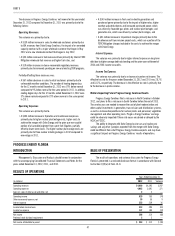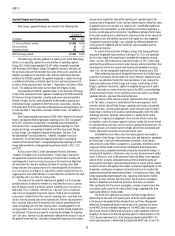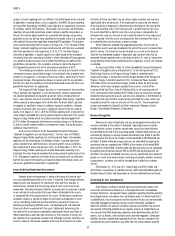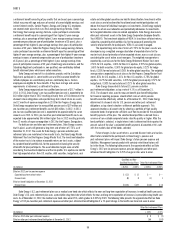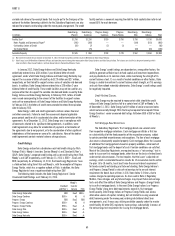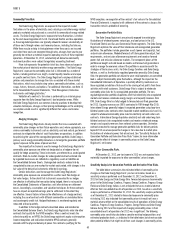Duke Energy 2012 Annual Report Download - page 73
Download and view the complete annual report
Please find page 73 of the 2012 Duke Energy annual report below. You can navigate through the pages in the report by either clicking on the pages listed below, or by using the keyword search tool below to find specific information within the annual report.
53
PART II
analysis. As each reporting unit has a different risk profi le based on the nature of
its operations, including factors such as regulation, the WACC for each reporting
unit may differ. Accordingly, the WACCs were adjusted, as appropriate, to account
for company specifi c risk premiums. For example, transmission and distribution
reporting units generally would have a lower company specifi c risk premium as
they do not have the higher level of risk associated with owning and operating
generation assets nor do they have signifi cant construction risk or risk associated
with potential future carbon legislation or pending EPA regulations. The discount
rates used for calculating the fair values as of August 31, 2012, for each of Duke
Energy’s domestic reporting units were commensurate with the risks associated
with each reporting unit and ranged from 5.2% to 7.1%. For Duke Energy’s
international operations, a country specifi c risk adder based on the average of
risk premium for each separate jurisdiction in which International Energy operates
was added to the base discount rate to refl ect the differing risk profi les of the
jurisdictions and countries. This resulted in a discount rate for the August 31,
2012 goodwill impairment test for the international operations of 8.5%.
The underlying assumptions and estimates are made as of a point in time;
subsequent changes, particularly changes in the discount rates or growth rates
inherent in management’s estimates of future cash fl ows, could result in future
impairment charges. Management continues to remain alert for any indicators
that the fair value of a reporting unit could be below book value and will assess
goodwill for impairment as appropriate.
The majority of Duke Energy’s business is in environments that are either
fully or partially rate-regulated. In such environments, revenue requirements
are adjusted periodically by regulators based on factors including levels of
costs, sales volumes and costs of capital. Accordingly, Duke Energy’s regulated
utilities operate to some degree with a buffer from the direct effects, positive
or negative, of signifi cant swings in market or economic conditions. However,
changes in discount rates may have a signifi cant impact on the fair value of
equity. As of August 31, 2012, all of the USFE&G reporting units’ estimated fair
value of equity exceeded the carrying value of equity by more than 10%, except
Progress Energy Florida which has preliminarily been allocated goodwill of
$2,457 million. Management will continue to monitor changes in the business,
as well as overall market conditions and economic factors that could require
additional impairment tests.
As discussed in Note 12 to the Consolidated Financial Statements,
“Goodwill, Intangible Assets and Impairments,” the fair value of USFE&G’s
Progress Energy Florida reporting unit and Commercial Power’s Renewables
reporting unit are impacted by a multitude of factors, including legislative
actions related to tax credit extensions, long-term growth rate assumptions,
the market price of power and discount rates. As of December 31, 2012, the
Progress Energy Florida reporting unit and the Renewables reporting unit’s
estimated fair value of equity exceeded the carrying value of equity by less than
10%. Management continues to monitor these assumptions for any indicators
that the fair value of the reporting unit could be below the carrying value, and
will assess goodwill for impairment as appropriate.
Long-Lived Asset Impairment Assessments
Property, plant and equipment is stated at the lower of historical cost
less accumulated depreciation or fair value, if impaired. Duke Energy evaluates
property, plant and equipment for impairment when events or changes in
circumstances indicate that the carrying value of such assets may not be
recoverable. The determination of whether an impairment has occurred is based
on an estimate of undiscounted future cash fl ows attributable to the assets,
as compared with the carrying value of the assets. Performing an impairment
evaluation involves a signifi cant degree of estimation and judgment in areas
such as identifying circumstances that indicate an impairment may exist,
identifying and grouping affected assets, and developing the undiscounted
future cash fl ows associated with the asset. Additionally, determining the
fair value of the asset requires probability weighting the future cash fl ows to
refl ect expectations about possible variations in their amounts or timing and
the selection of an appropriate discount rate. Although cash fl ow estimates are
based on relevant information available at the time the estimates are made,
estimates of future cash fl ows are, by nature, highly uncertain and may vary
signifi cantly from actual results. If an impairment has occurred, the amount
of the impairment recognized is determined by estimating the fair value of the
asset and recording a loss if the carrying value is greater than the fair value.
For assets identifi ed as held for sale, the carrying value is compared to the
estimated fair value less the cost to sell in order to determine if an impairment
loss is required. Until the assets are disposed of, their estimated fair value is
re-evaluated when circumstances or events change.
When it becomes probable that regulated generation, transmission or
distribution assets have been abandoned, the cost of the asset is removed from
plant in service. The value that may be retained as an asset on the balance
sheet for the abandoned property is dependent upon amounts that may be
recovered through regulated rates, including any return. As such, an impairment
charge could be offset by the establishment of a regulatory asset if rate recovery
is probable.
As discussed further in Note 12 to the Consolidated Financial Statements,
“Goodwill, Intangible Assets and Impairments,” in the third quarter of 2012,
Duke Energy Carolinas and Progress Energy Carolinas recorded certain
impairment charges in conjunction with the merger between Duke Energy and
Progress Energy. In the third quarter of 2011, Commercial Power recorded
$79 million of pre-tax impairment charges related to Clean Air Act emission
allowances which were no longer expected to be used as a result of the
issuance of the fi nal Cross State Air Pollution Rule. In the second quarter of
2010, Commercial Power recorded $160 million of pre-tax impairment charges
related to certain generating assets and emission allowances in the Midwest to
write-down the value of these assets to their estimated fair value, which was
impacted by the EPA’s rules on emissions of NOx and SO2. These impairment
charges are recorded in Goodwill and Other Impairment Charges on Duke
Energy’s Consolidated Statement of Operations.
Revenue Recognition
Revenues on sales of electricity and gas are recognized when either the
service is provided or the product is delivered. Operating revenues include
unbilled electric and gas revenues earned when service has been delivered
but not billed by the end of the accounting period. Unbilled retail revenues are
estimated by applying an average revenue per kilowatt-hour (kWh) or per Mcf
for all customer classes to the number of estimated kWh or Mcf delivered but
not billed. Unbilled wholesale energy revenues are calculated by applying the
contractual rate per megawatt-hour (MWh) to the number of estimated MWh
delivered but not yet billed. Unbilled wholesale demand revenues are calculated
by applying the contractual rate per MW to the MW volume delivered but not
yet billed. The amount of unbilled revenues can vary signifi cantly from period to
period as a result of numerous factors, including seasonality, weather, customer
usage patterns, customer mix and the average price in effect for customer
classes.
At December 31, 2012 and 2011, Duke Energy had $920 million and
$674 million, respectively, of unbilled revenues within Restricted Receivables of
Variable Interest Entities and Receivables on the Consolidated Balance Sheets.
Accounting for Loss Contingencies
Duke Energy is involved in certain legal and environmental matters that
arise in the normal course of business. In the preparation of its consolidated
fi nancial statements, management makes judgments regarding the future outcome
of contingent events and records a loss contingency when it is determined that it
is probable that a loss has occurred and the amount of the loss can be reasonably
estimated. Management regularly reviews current information available to
determine whether such accruals should be adjusted and whether new accruals
are required. Estimating probable losses requires analysis of multiple forecasts
and scenarios that often depend on judgments about potential actions by third
parties, such as federal, state and local courts and other regulators. Contingent
liabilities are often resolved over long periods of time. Amounts recorded in the
consolidated fi nancial statements may differ from the actual outcome once the






